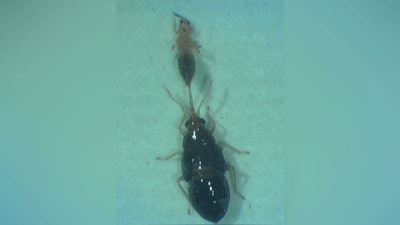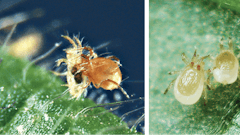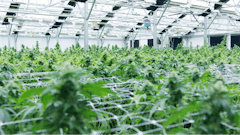
Survivability at low prey densities is one important feature of predators.
Biological control agents, such as parasitoids and predators, are purchased from commercial biological control suppliers or distributors and are released into greenhouses to regulate insect or mite pest populations. These biological control agents must be effective in keeping insect or mite pest populations below plant-damaging levels. But what are the attributes that biological control agents must have to effectively regulate insect or mite pest populations and prevent damage to cannabis crops? When sourcing biological control agents, ensure vendors can guarantee they have the following six features:
1. Efficient searchers
Biological control agents must be able to search for and locate hosts or prey at low densities on plants to prevent potential outbreaks, which may be accomplished by detecting prey odors or their movement. In general, an efficient searching ability will lead to low pest population densities, resulting in less damage to greenhouse- and indoor-grown crops.
2. High parasitism or predation rate
Parasitoids and predators must kill insect or mite pests at a greater rate than the reproductive rate of female pests to keep pest populations below plant-damaging levels. Furthermore, biological control agents must provide sufficient mortality as host or prey populations increase to avoid pest outbreaks. For example, a high parasitism rate would be 80% to 90% of the aphids on a plant parasitized by female parasitoids. Another example of a high predation rate might be the ability of a predator to consume up to 30 thrips in 24 hours, but this will vary depending on the biological control agent; ask suppliers for more information.
3. High reproductive potential
Female biological control agents should produce high numbers of offspring to keep up with the reproductive capacity of various insect and mite pests, including aphids and the twospotted spider mite, Tetranychus urticae. In addition to a high reproductive potential, there should be multiple generations of the biological control agents present during the crop growing season. For example, some parasitoid females can produce 200 eggs during their lifespan. In the insect/mite world, it is a “numbers game.” Biological control agents will only be effective in managing pest populations if females can reproduce enough offspring to keep mite and insect pest populations below plant damaging levels.
4. Minimal handling time
The handling time refers to the time that a biological control agent (e.g. parasitoid or predator) spends parasitizing or feeding on prey. Biological control agents should spend less than 30 minutes on average either parasitizing or consuming prey. However, the handling time will depend on the specific biological control agent. Biological control agents should consume prey quickly (predators) or lay eggs rapidly (parasitoids) so more time can be devoted to searching, locating and attacking additional prey. In general, small populations of a biological control agent with minimal handling time may be more effective in regulating a designated insect or mite pest population than high populations of a biological control agent with a long handling time.
5. Survival Abilities
Biological control agents must be effective in regulating insect or mite pest populations below plant-damaging levels. However, biological control agents must maintain a low enough number of insect or mite pests to sustain their populations without eliminating any food sources. Growers must scout to determine trends (up, down, or unchanged) in insect or mite populations to assess whether they need to purchase and make releases of biological control agents. If sufficient numbers of a biological control agent are released initially early in the production cycle, then growers may not have to make any additional releases. However, this will depend on the specific agent. For example, if the predatory mite, Phytoseiulus persimilis, consumes all the twospotted spider mites on a cannabis crop, then they will starve. Consequently, if populations of twospotted spider mites return, then the grower will have to make another release of P. persimilis.
6. Ability to adapt to a wide range of environmental conditions
Parasitoids and predators must be able to adapt to a variety of temperatures, relative humidities and day length conditions to be effective in regulating insect or mite pest populations. For instance, above a certain temperature (54°F or 12°C), the greenhouse female whitefly parasitoid, Encarsia formosa, has a higher reproductive capacity than the female greenhouse whitefly Trialeurodes vaporariorum. However, the reverse is true below a certain temperature.
Also, at an optimal temperature (65 to 80°F or 18 to 26°C) and relative humidity (above 60%), the predatory mite, Phytoseiulus persimilis, will effectively regulate populations of the twospotted spider mite. However, when temperatures exceed 86°F (30°C) and/or the relative humidity is less than 60%, the predatory mite will no longer regulate twospotted spider mite populations below plant-damaging levels. Consequently, additional predatory mites are commercially available, such as Neoseiulus californicus, Galendromus occidentalis and Amblyseius andersonii, that tolerate higher or lower temperatures and lower relative humidities than P. persimilis.
Editor’s Note: A version of this article originally ran in the January 2022 issue of GIE Media publication Greenhouse Management, and it has been updated.
Dr. Raymond Cloyd is a professor and extension specialist in horticultural entomology/plant protection in the Department of Entomology at Kansas State University. [email protected]




















